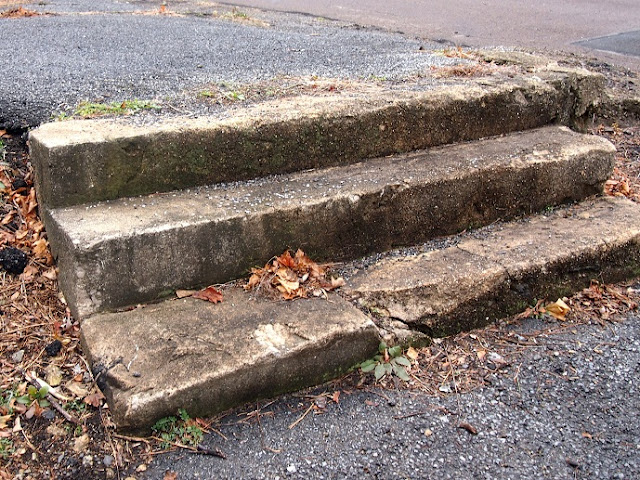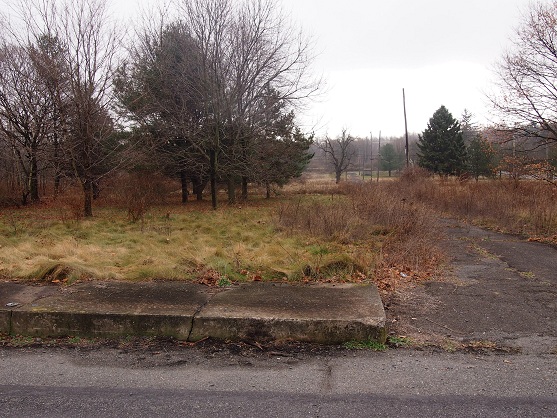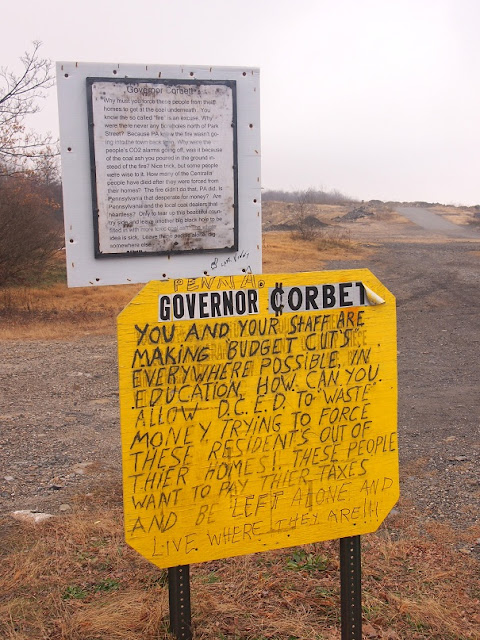December 8, 2012 — Five and a half years ago, I visited Centralia, Pennsylvania. It was the early days of my OTIS adventure, back when I was still learning how to leave my living room and the big-screen tube TV I had splurged on at the expense of any other furniture in my apartment (and, almost, my apartment itself). It was my ninth post, just after the Dark Crystal Skeksis and right before the Cave of Kelpius.
Since that time, a lot has happened to me. I moved to New England. Got a wife. A kid. A cancer. Published two books. Quit four jobs. Seen more fascinating things than a guy as ferociously suburban as myself deserves to.
Meanwhile, Centralia kept burning. As it has for the past 50 years. As it will for the next couple of hundred.
But I went and visited it again just a few days ago, just to make sure.
If you think of the shape of Pennsylvania—like I do and I assume the nearby Hershey’s candy company does—as a giant chocolate bar with a bite for an eastern border, then Centralia is located just 80 miles directly west of that bite mark.
It was established in the mid-1800s, and, like many towns in the region, started out as a mining town. Anthracite coal was what it was built on then, and anthracite coal is what it burns on now. In 1962, a simple trash fire at the local dump ignited a bit of exposed coal that happened to be just the tip of the coalberg.
It ignited a coal mass that stretched for miles beneath the town and the surrounding areas. The fire spread slowly and stealthily over the next couple of decades, until it became obvious that something was wrong. Really wrong. Hell had added a few more stories to its roof, and Centralia was in its way.

Short version: Centralia is a ghost town….on fire.
Since that time it has gotten a reputation as a toxic horrorland full of winking sinkholes and carcinogenic clouds of death vapor.
Honestly, though, it’s kind of the opposite. Heck, I took my wife and toddler to it this time. But even though it doesn’t live up to those extreme expectations, it’s still a fascinating, haunting place.
On my previous visit, the weather had been “sunny as Sesame Street,” but on the morning of my most recent jaunt it was foggy. Real foggy. Like Silent Hill foggy. Perfect.
You get to Centralia by merely following Route 61. It cuts directly through what remains of the site. Takes you right downtown.
Or, at least, what passes for a downtown for such a place.
Centralia is pretty much just a grid of overgrown streets. Here and there along those streets you’ll see a bit of curb or a section of stone fence or an orphaned stretch of sidewalk, but mostly it’s just a field with some trees. People do still live there, though, and a couple of houses and a bland-looking municipal building can be found at points within and around that immediate grid. One of the houses, with its flat, windowless flank, looked to have originally been part of a row in those nostalgic days before tragic mine fires.
Eventually, I did find the stone marking the time capsule, but the bench was gone, as was the house across the street. Not even a foundation stone was left for future archeologists. The veterans memorial had been reduced to a crumbling stack of cinderblocks, the bell nowhere to be seen. The whole tableau blended pretty well with the rest of the desolation. A small section of rusty chain-link fence lined by a couple of trees is the nearest landmark to it.
This time, a pair of homemade signs welcomed us to that part of the town…by excoriating the state governor for faking the fire to get rid of the town and gain access to the lucrative coal underneath. I don’t know if the A-Team ever had an episode like that, but it's exactly the kind of injustice that got B.A. Baracus so angry.
While we walked the black mounds of ash and dirt and scrub brush, the smoke wafted in small plumes like ghosts that blended into the slate sky. Due to the weather conditions, the smoke was more tenuous on this visit and sometimes we had to really focus [our cameras] to see it. But it was there, no doubt. The forever incense of a town sorry for its sins. Somebody bet me I wouldn’t write that line. I win. I think.
But I’m not telling you that from experience. The way I arrived at the fissure last time and this time is by simply getting back in my car and heading south on the current Route 61 about a mile to where it intersects with the other end of the abandoned route. It’s a lot easier than I’m explaining it. Just look at Centralia on Google Maps and it’ll show you the abandoned stretch of road that starts at the south end of the town. It’s less than a mile long, and Google Maps calls it Pennsylvania 61 Destroyed. It’s the name of the album Bob Dylan should have written.
Of course, that said, I actually missed the other end of it a couple of times this time around. Five years ago, where they met was pretty obvious. A large four-foot-tall dam of dirt just off the road blocked vehicular entry, and a warning sign said horrible things about your future health if you continued exploring.
Today that sign is gone, and the road now curves away from the abandoned stretch. To find it now, just look for the sharp curve marked by about half a dozen orange signs with black arrows. At the end of that curve is a small entrance you can drive through if you don’t care too much about the undercarriage of your car. After a few feet it stops at a flat bit of asphalt where you can park. That’s where the dirt mound is, and that’s where old route 61 is.
They sped past us in the direction of the crack using the wavy sections of asphalt as ramps and making black streaks across the bright graffiti. When we finally got there, they were all just hanging out, sweaty and helmet-less, their bikes angled on kickstands as they stared down in awe at the massive road damage.
The fissure wasn’t really smoking on this visit, but it was still impressive, sinuating itself a good 100 feet or so along the right lane, about two feet deep and five feet wide at its broadest. Disaster movies always make sure to show roads disintegrating in all the chaos of destruction. It’s a metaphor that means “no escape.” Disaster movies are deep, man.
By the time the dirt bikers left, a group of young geocachers came by, who nicely offered us a can of spray paint to sign our names on the road. We didn’t. It’s not an OTIS article without at least one regret. Instead, we somberly walked back the way we came, got into our car, and headed through the still-lingering fog around Centralia into the real world.
A lot of people, including myself, are slightly disappointed with their first experience in Centralia. But you know what? Now that I’ve visited it twice, I can tell you. It sticks with you. It really does.






















